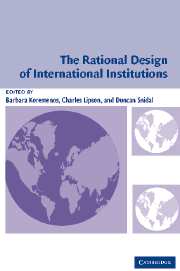Book contents
- Frontmatter
- Contents
- Contributors
- Abstracts
- Title Page
- The Rational Design of International Institutions
- Trust Building, Trust Breaking: The Dilemma of NATO Enlargement
- The Optimal Design of International Trade Institutions: Uncertainty and Escape
- Most-Favored-Nation Clauses and Clustered Negotiations
- Situation Structure and Institutional Design: Reciprocity, Coercion, and Exchange
- Private Justice in a Global Economy: From Litigation to Arbitration
- Multilateralizing Trade and Payments in Postwar Europe
- The Institutional Features of the Prisoners of War Treaties
- Institutions for Flying: How States Built a Market in International Aviation Services
- Driving with the Rearview Mirror: On the Rational Science of Institutional Design
- Rational Design: Looking Back to Move Forward
- References
Multilateralizing Trade and Payments in Postwar Europe
Published online by Cambridge University Press: 28 October 2009
- Frontmatter
- Contents
- Contributors
- Abstracts
- Title Page
- The Rational Design of International Institutions
- Trust Building, Trust Breaking: The Dilemma of NATO Enlargement
- The Optimal Design of International Trade Institutions: Uncertainty and Escape
- Most-Favored-Nation Clauses and Clustered Negotiations
- Situation Structure and Institutional Design: Reciprocity, Coercion, and Exchange
- Private Justice in a Global Economy: From Litigation to Arbitration
- Multilateralizing Trade and Payments in Postwar Europe
- The Institutional Features of the Prisoners of War Treaties
- Institutions for Flying: How States Built a Market in International Aviation Services
- Driving with the Rearview Mirror: On the Rational Science of Institutional Design
- Rational Design: Looking Back to Move Forward
- References
Summary
The liberalization of intra-European trade in the years immediately following World War II offered potentially large welfare gains to European societies. In this period European trade flowed through a network of two hundred bilateral agreements. In the two years after the war intra-European trade increased rapidly within this bilateral framework, but by 1947 the growth had halted. Shifting from this bilateral system to a multilateral clearing union could have provided a first step toward trade expansion. In spite of the potential benefits multilateral clearing offered, however, it was not until September 1950 that European governments established an effective multilateral clearing union, the European Payments Union (EPU).
Once established, the EPU had a dramatic impact on intra-European trade. The clearing union freed trade credit and greatly reduced European governments' need to resort to discriminatory quantitative restrictions for balance-of-payments considerations. Trade liberalization within the framework of the Organization for European Economic Cooperation (OEEC) quickly followed. By 1954 80 percent of intra-European trade had been freed from quantitative restrictions, and governments had begun to consider meaningful tariff reductions as well. Thus, inducing European governments to enter a multilateral clearing union in 1950 marked the critical first step toward nondiscriminatory trade in postwar Europe.
I use the Rational Design framework to explore how the institutional structure supporting the multilateral payments arrangements facilitated Europe's shift to multilateralism. This question has received little explicit attention in the existing literature.
- Type
- Chapter
- Information
- The Rational Design of International Institutions , pp. 189 - 210Publisher: Cambridge University PressPrint publication year: 2003



